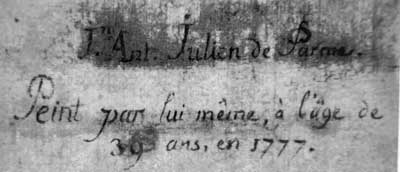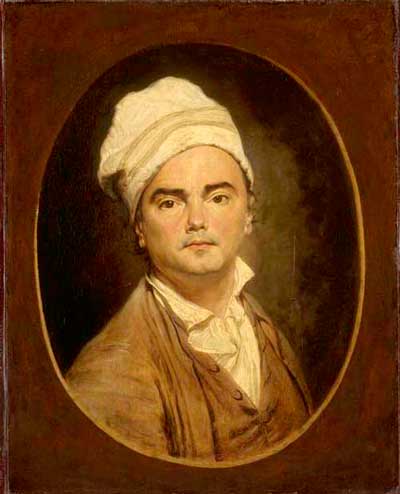
- Home Page
- Accepted
Paintings & Copies - Doubtful
Attributions - Doubtful Textual References
- Alternative
Titles - Collectors &
Museums - Bibliography
- Search Abecedario
- Watteau &
His Circle
X. Homme au bonnet (Autoportrait de Jean Antoine Julien)
Entered November 2016; revised February 2017
Paris, Musée du Louvre, inv. R.F. 2483
Oil on canvas
61 x 48.9 cm
ALTERNATIVE TITLES
Un Artiste
Autoportrait à 39 ans
Autoportrait au bonnet
Autoportrait de Julien de Parme
PROVENANCE
Paris, collection of prince George Barbu Stirbey [Stirbei] (1832-1925; Rumanian diplomat).
Paris, collection of an unnamed antique dealer; bought from him by the Musée du Louvre in 1925 for 300,000 francs.
EXHIBITIONS
Paris, Orangerie, Achats du musée du Louvre (1933), cat. 118 (École française [XVIIIe siècle], Portrait d’un jeune homme).
Paris, Orangerie, Le Portrait français (1957), cat. 93 (École française du XVIIIe siècle, Portrait d’homme au bonnet, lent by the Musée du Louvre).
Munich, Residenz, Europäisches Rokoko (1958), cat. 60 (École française, XVIIIe siècle, Portrait d’un artiste au bonnet [L’Homme au bonnet], lent by the Musée du Louvre).
Paris, Louvre, 700 Tableaux tirés des reserves (1960), cat. 710 (École française du XVIIIe siècle, Portrait d’homme au bonnet, lent by the Musée du Louvre).
Paris, Louvre, La Société française (1964), cat. 33 (École française du XVIIIe siècle, Portrait d’homme au bonnet, lent by the Musée du Louvre).
Paris, Louvre, Copies, répliques, pastiches (1973), cat. 89 (École française, XVIIIe siècle, Portrait d’homme au bonnet, lent by the Musée du Louvre).
Paris, Musée d’art et d’essai, L’Attribution (1978), unnumbered (École française, XVIIIe siècle, Portrait d’homme au bonnet, lent by the Musée du Louvre).
Paris, Musée des arts décoratifs, La Famille des portraits (1979), cat. 42 (Anonyme, XVIIIe siècle, lent by the Musée du Louvre).
Paris, Musée Bourdelle, Chapeau! (1980), cat. 110 (Anonyme, France, Portrait d’homme, lent by the Musée du Louvre).
Paris, Louvre, Le Tableau du mois no 112, ed. M. Sahut(2004) (by Julien de Parme, Autoportrait, lent by the Musée du Louvre).
Paris, Louvre, L’Envers du tableau (2004), cat. 20 (by Jean Antoine Julien, Autoportrait, lent by the Musée du Louvre).
SELECT BIBLIOGRAPHY
Jamot, “Un Portrait d’inconnu” (1925), 277-81.
Gillet, La Peinture au Musée du Louvre (1929),43.
Thiébault-Sisson, ”Un Watteau inconnu” (1933).
Isarlov, “La Peinture ancienne” (1933), 373.
Guiffrey, “À propos d’un portrait anonyme” (1933).
Adhémar, Watteau (1950), cat. 293.
Macchia and Montagni, L’opera completa di Watteau (1968), cat. 3o K.
Ferré, Watteau (1972), cat. B 75.
Paris, Louvre, Catalogue des peintures. École française (1972), 417.
Paris, Louvre, Catalogue illustré (1972), cat. 991.
Compin and Roquebart, Catalogue sommaire (1986), 313.
Rosenberg, Dictionnaire amoureux du Louvre (2007), 495-96.
Gimpel, Journal d’un collectioneur (2011), 487.
Pomarède, Merlini, and Storti, L’Amour et Psyche (2013), 138-39.
Rykner, “Attribution d’un tableau” (2014).
REMARKS
When this portrait was in the collection of prince Stirbey, it was attributed to Watteau, but it was apparently unknown to Watteau scholars. Only after the Louvre purchased this picture did it come to public attention. Paul Jamot, curator of paintings at the Louvre, praised the quality of the new acquisition but allowed that it might be by Watteau or Chardin. Paul Vitry, curator of sculpture at the Louvre, quickly followed suit with praise. However, at the Louvre it was catalogued simply as a French work of the eighteenth century. In 1933, disregarding these early texts, Thiébault-Sisson published a notice about the painting in Le Temps. He claimed to have discovered this supposedly unknown painting in the Louvre, and he proclaimed that it was a masterpiece by Watteau, but he was chided a month later by Jules Guiffrey for having disregarded the previous studies.
The attribution to Watteau, however, soon gave way to doubt. By mid-century Adhémar excluded the painting from her catalogue of Watteau’s oeuvre, classifying it “école de Watteau, douteux, incertains.” Ferré, despite his negativity toward so many authentic Watteau pictures, surprisingly supported this picture’s attribution. Most other Watteau scholars, including Roland Michel, Posner, Temperini, and Glorieux, have not discussed it, which was their way of rejecting it. Although the portrait was frequently exhibited in the second half of the twentieth century, it was presented as an anonymous work of the later eighteenth century, unrelated to Watteau or his circle. Indeed, the portrait’s frankness and directness of expression, as well as its suavity of color, have much more in common with Chardin’s self-portraits of the 1760s and ’70s.

Inscription on the reverse side of Homme au bonnet.
In 1927, the Parisian dealer René Gimpel recorded in his diary that a week after the painting had been bought by the Louvre, museum officials learned that twenty years earlier people had seen an inscription “Mon portrait” on the reverse of the canvas, signed by an artist of the second half of the century. However, after the canvas was relined, no one could remember the name of that artist. Gimpel’s tale was not taken seriously, however, especially because it was thought that the painting had not been relined. Not until 2002, when the painting was in the Louvre’s conservation laboratories, was it realized that the painting had indeed been relined. Once the relining was removed, the old signature was revealed fully: “Jn Ant. Julien de Parme. / Peint par lui même, à l’âge de / 39 ans, en 1777.” The enigma might now seem resolved, were it not that, as Marie-Catherine Sahut has pointed out, the painter’s age in 1777 was not thirty-nine but a few years older.
Jean Antoine Julien (1736-1799), a Swiss-born artist, is best remembered as a history painter who trained in Paris and then in Rome, before returning to Paris. Significantly, in his early career he had supported himself as a portraitist, yet none of those early portraits survived, which helps to explain why the Louvre picture had not previously been associated with his name. The great irony is that a monographic exhibition of Julien’s work was held in Rancate (Switzerland) and Parma in 1999-2000, a scant few years before this self-portrait was identified.
